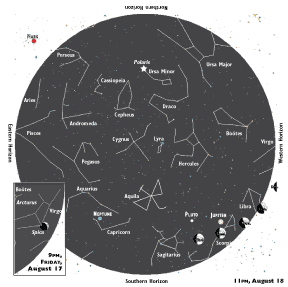The Coming Darkness
Summer’s long days are winding down
The sun this week crosses a milestone of sorts, setting at 8pm on Friday and roughly a minute earlier each night this week; by next Friday, the sun sets at 7:50. Old Sol is losing ground in the morning, too, rising at 6:23 this Friday and at 6:29 the next.
Escaping the sun’s glare, the waxing moon moves into darkness this week. Thursday’s crescent hovers low against the horizon at dusk, a little to the south of due west and setting at 9:30. The next evening, a more bulbous crescent appears higher and more to the south at dusk, with the glaring-white light of Spica three degrees higher.
Spica, the 16th-brightest star in the heavens, is 2,100 times brighter than our own sun. Viewed through at our Earth-bound vantage 260 light years distant, Spica shines as a blueish first-magnitude star. However, it is actually a pair of stars orbiting one another at one-fourth the distance between our sun and Mercury.
In Latin, spica means ear of wheat, which is what the star represents in the constellation Virgo, one of only three women represented in the night sky (the other two being Cassiopeia and Andromeda).
Holding the sheaf of grain in her left hand and a palm branch in her right, Virgo represents feminine virtue, fertility and innocence. As the Greek goddess Demeter, she nurtured the land and its people, and all flourished with abundance. But in a loss of innocence, her daughter Persephone was abducted by Hades, ruler of the underworld. With Demeter’s grief, famine swept the land until a compromise freed Persephone for half the year. As summer’s sun yields to darkness, Persephone prepares her return to the underworld.
Tidelog®
Illustration: © Copyright 1925 M.C. Escher/Cordon Art-Baarn-Holland; Graphics: © Copyright 2007 Pacific Publishers. Reprinted by permission from the Tidelog graphic almanac. Bound copies of the annual Tidelog for Chesapeake Bay are $14.95 ppd. from Pacific Publishers, Box 480, Bolinas, CA 94924. Phone 415-868-2909. Weather affects tides. This information is believed to be reliable but no guarantee of accuracy is made by Bay Weekly or Pacific Publishers. The actual layout of Tidelog differs from that used in Bay Weekly. Tidelog graphics are repositioned to reflect Bay Weekly’s distribution cycle.Tides are based on National Oceanic and Atmospheric Administration and are positioned to coincide with high and low tides of Tidelog.
